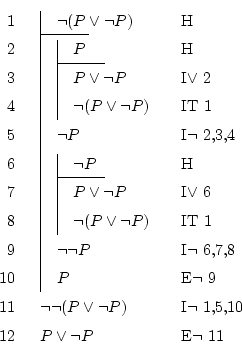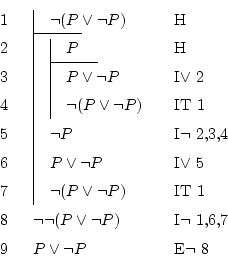Next: 5.12 An interesting one. Up: 5 Explained exercises Previous: 5.10 Suppose the contrary. Contents
Let's see if
![]() is as easy as some say:
is as easy as some say:

One of the simplest but longest I found. It seems even unnecessary to prove this, since everyone knows that between ``today it's Thursday'' and ``today it's not Thursday'', one of them is true (they can't be both be false at the same time).
We could start by thinking in the proof by cases method, since
from ![]() we can extract
we can extract ![]() , and from
, and from ![]() we can
extract
we can
extract ![]() , so, the same formula. But this doesn't help,
since proof by cases is the disjunction elimination,
and we don't have any disjunction to eliminate; in fact, we also don't
have the truth formula
, so, the same formula. But this doesn't help,
since proof by cases is the disjunction elimination,
and we don't have any disjunction to eliminate; in fact, we also don't
have the truth formula ![]() in which
in which
![]() and
and
![]() ,
as the rule needs. Actually, we don't have any formula which we know
it's true (as the left part of the sequent is empty).
,
as the rule needs. Actually, we don't have any formula which we know
it's true (as the left part of the sequent is empty).
We know that we must start with a hypothesis (there's no alternative).
Since it's rather clear that ![]() is true, it may also be
easy to prove that its contrary,
is true, it may also be
easy to prove that its contrary,
![]() , is false. So
we will use reduction to the absurd: doing that supposition
on line 1, we must achieve a contradiction, any one.
, is false. So
we will use reduction to the absurd: doing that supposition
on line 1, we must achieve a contradiction, any one.
I proposed myself to achieve the contradiction![]() and
and ![]() .
But we don't have any of these formulas; how can we obtain them? Doing
reduction to the absurd again is an option: to see that
.
But we don't have any of these formulas; how can we obtain them? Doing
reduction to the absurd again is an option: to see that ![]() ,
suppose that
,
suppose that ![]() and get a contradiction. As we did in another occasions,
it's very useful to profit the capabilities of the disjunction
introduction: having supposed
and get a contradiction. As we did in another occasions,
it's very useful to profit the capabilities of the disjunction
introduction: having supposed ![]() , we can convert it to
, we can convert it to ![]() to search our contradiction. As we have the
to search our contradiction. As we have the
![]() at
the top, we can use it to finish by demonstrating
at
the top, we can use it to finish by demonstrating ![]() . We can
do the same to prove
. We can
do the same to prove ![]() , but this time supposing
, but this time supposing ![]() .
.
Having obtained ![]() and
and ![]() after supposing
after supposing
![]() ,
we see that this formula can't be true, so its negation,
,
we see that this formula can't be true, so its negation,
![]() ,
is. By negation elimination, we get our searched formula:
,
is. By negation elimination, we get our searched formula: ![]() .
.
I did it this way to make it rather symmetrical, but it can be shorter
if we search another contradiction, for instance ![]() and
and
![]() . Then it would be like this:
. Then it would be like this:

Daniel Clemente Laboreo 2005-05-17